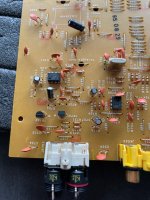Good Morning, I have a old Luxman D-355 that I like to restore / fresh up.
It have two Op-Amps after DAC chip ( analog out ). The units is NJM2100D ( dual ) from JRC, is it worth change them?
I also thinking of re-cap, the unit is from 1995 so 30 years old. But I like the way it present the music with the 1 bit DAC.
I think of good all around caps for the board except maybe some audio caps for the analog part.
Any thoughts ?
Frank
It have two Op-Amps after DAC chip ( analog out ). The units is NJM2100D ( dual ) from JRC, is it worth change them?
I also thinking of re-cap, the unit is from 1995 so 30 years old. But I like the way it present the music with the 1 bit DAC.
I think of good all around caps for the board except maybe some audio caps for the analog part.
Any thoughts ?
Frank
New electrolytic capacitors, sure.
Leave everything else, as is.
Leave everything else, as is.
The opamps are a puzzle... the NJM2100 is a very low voltage device capable of operating on just 2 volts (total supply) and has an absolute max rating of just 7 volts. They are usually used in battery powered devices...
So definitely do not replace those without a full understanding of the circuitry and the ability to substitute them.
So definitely do not replace those without a full understanding of the circuitry and the ability to substitute them.
Hi again, I have now the PCB on the table and have looked at the analog signal out and there are 2 200R and 1 50K resistors between po-amp and RCAs.
Go with Vishay Naked or Carchroft Z - foil there. I also have a few Ceramic capacitors in analog signal out, leave them or put in some new? And I change the electrolytics with a mix of Panasonic FM, Cerafine, AN Kaisei and Toshin.
Frank
Go with Vishay Naked or Carchroft Z - foil there. I also have a few Ceramic capacitors in analog signal out, leave them or put in some new? And I change the electrolytics with a mix of Panasonic FM, Cerafine, AN Kaisei and Toshin.
Frank
I have to say I'm not a believer in most passive parts swaps beyond replacing aged electrolytics. Resistors will make no difference to a line level feed. Ceramic caps might be ceramic for a reason and you really would have to look at what function they perform before looking for alternatives.
If it is a 1 bit DAC like the TDA1305 then there will be small value caps in the reconstruction output filter around the opamps and those caps have to deal with high frequency noise and hash from the 1bit Bitstream DAC so they are pretty critical.
If it is a 1 bit DAC like the TDA1305 then there will be small value caps in the reconstruction output filter around the opamps and those caps have to deal with high frequency noise and hash from the 1bit Bitstream DAC so they are pretty critical.
I'm just going to mention those opamps again because I'm amazed such a part would be used. The data sheets are easily searchable and you will see they really are a low power low voltage device of OK but nothing more performance. The absolute supply limit of just 7 volts (and that is absolute max and above the recommended value) means they would not deliver the normal CD output voltage of '2 volts rms' which is is -/+2.8 volts peak to peak.
Are you 100% sure they are in the signal path? Has anyone changed them to these in the past?
Something doesn't add up with using those for a high quality audio product if they are used in the signal path.
Try measuring the supply voltages on pins 4 and 8 and see what it is running on.

Are you 100% sure they are in the signal path? Has anyone changed them to these in the past?
Something doesn't add up with using those for a high quality audio product if they are used in the signal path.
Try measuring the supply voltages on pins 4 and 8 and see what it is running on.
Do you have the service manual and schematics?
I'ts very hard to make any intelligent choices without knowing exactly the circuit that one is dealing with.
I'ts very hard to make any intelligent choices without knowing exactly the circuit that one is dealing with.
Thanks for that. So the opamps look untouched and original.
I'll be totally honest here and say I'm more than a bit shocked at the board and its quality and for what seems to be a high end player.
Just to be certain we are talking of the same player... one of these?

All those ceramics look like they will be in the audio path (reconstruction filters) and I'm really astounded seeing those.
The data sheets don't lie 🙂 and the opamps are pretty mediocre at best but given they run on a low voltage and can't actually run on anything other than a very low supply (please please look at the data sheet and look for yourself) makes substitution more difficult.
The data sheet attached lists the typical applications for this chip... I'll let you read it.
I'll be totally honest here and say I'm more than a bit shocked at the board and its quality and for what seems to be a high end player.
Just to be certain we are talking of the same player... one of these?
All those ceramics look like they will be in the audio path (reconstruction filters) and I'm really astounded seeing those.
The data sheets don't lie 🙂 and the opamps are pretty mediocre at best but given they run on a low voltage and can't actually run on anything other than a very low supply (please please look at the data sheet and look for yourself) makes substitution more difficult.
The data sheet attached lists the typical applications for this chip... I'll let you read it.
Attachments
Yeah, I had a Marantz (4001? 5001?) CD player that had the same style in the DAC and it's euphonic to say the least...
Compared to an old Philips that may sound edgy but it's more precise ( who knows if the micro switches are still working?...). Now I'm sold to Panasonic BR players for CD listening...basic
Compared to an old Philips that may sound edgy but it's more precise ( who knows if the micro switches are still working?...). Now I'm sold to Panasonic BR players for CD listening...basic
techtool: I have been in contact with Luxman dealer in Norway, and they have contacted Luxman in Japan. They can not find some service manual on the D-355. Luxman was owned by Samsung until 1994, so maybe a transition there.
Mooly: Yes same player. Thanks for info, Ill read it.
picowallspeaker: I must say compare to my tuned SA15S1 i sound more thin, not so body but damn it is so right and as you say precise. I like it.
What do you mean with the micro switches?
Frank
Mooly: Yes same player. Thanks for info, Ill read it.
picowallspeaker: I must say compare to my tuned SA15S1 i sound more thin, not so body but damn it is so right and as you say precise. I like it.
What do you mean with the micro switches?
Frank
Mooly: Yes same player. Thanks for info, Ill read it.
Also never lose sight of the fact you like the player 🙂
Sometimes designs and component choices do actually work well sonically. It's only when we know what's in there that we suddenly start questioning things and wondering if we could do better.
Well, I was making the comparison between the Philips ( special late 80s CD data player with audio facility!) and the Marantz (entry level) about 10 years ago.picowallspeaker: I must say compare to my tuned SA15S1 i sound more thin, not so body but damn it is so right and as you say precise. I like it.
What do you mean with the micro switches?
I had big 3 ways with 15", and Audax Pm 170 MO and Audax tweeter A025 something so the best thing you can do is listen very close (or at high volume...) to whatever piano, violin, piano-violin, attack, decay, drums, voices.
The old Philips ( LM 833 inside) had better resolution, though on the cold side, edgy & metallic but different from the Marantz.which might be warmer but in the sense of soft interpolation, fuzzy.
There's no shortage of 5V supply rail-to-rail opamps these days. But they will all likely require better decoupling than the D-255 PCB has fitted, so one approach is fitting a modern opamp and decoupling capacitor on a little piggy-back PCB.The data sheets don't lie 🙂 and the opamps are pretty mediocre at best but given they run on a low voltage and can't actually run on anything other than a very low supply (please please look at the data sheet and look for yourself) makes substitution more difficult.
Lets hope all those ceramics are type I ceramic!
This is indeed a D-355. Found a picture of the internals. https://www.audiovintage.fr/leforum/viewtopic.php?t=41274
This was a really expensive player at that time, 1996. Seems like they used the cheapest stuff they could find. It is made in China as well, so new owners just cashed in on the good Luxman name. Even the cheapest Marantz player of that time had more "audiophile" parts you would expect in something made for audio reproduction.
The funny opamp may have been used to get rid of the usual +-12 Volt stabilized power supply needed for the usual NE/JR5532 or similar parts.
Maybe don't touch it if you like the sound.
You could add a good 15 Volt power supply and instead of the NJM2100 install a nice line driver PCB. Anyway, looking at the complete picture doesn't encourage me to change anything on this object.
This was a really expensive player at that time, 1996. Seems like they used the cheapest stuff they could find. It is made in China as well, so new owners just cashed in on the good Luxman name. Even the cheapest Marantz player of that time had more "audiophile" parts you would expect in something made for audio reproduction.
The funny opamp may have been used to get rid of the usual +-12 Volt stabilized power supply needed for the usual NE/JR5532 or similar parts.
Maybe don't touch it if you like the sound.
You could add a good 15 Volt power supply and instead of the NJM2100 install a nice line driver PCB. Anyway, looking at the complete picture doesn't encourage me to change anything on this object.
Turbowatch2: I see you, it does not look very "high end" 🤣
But I will give it a try. I look at the 15V PS.
But I will give it a try. I look at the 15V PS.
Remember it is possible the biasing for the opamps (assumed to be 2.5 volts for a 5 volt single ended supply) comes from direct coupling to the DAC and that increasing the opamp supply alone may not actually alter the available output swing. A rail to rail opamp would likely still be needed although the 5 volt constraint would be lifted.
If you want to go further with this player, first measure the voltage at the opamps legs to find out what it is, single or dual voltage.
If you really want to modify it, I may give you some ideas. I only like modify a player when I have two of them. So I can check what has changed from a mod. This is not always possible, so I use a relay switching unit, which is remote controlled. With two CD players I do A-B testing. Aim is to find two that sound identical. Of course, both have to be at the exact same level. A good idea is to use copys of an audio CD and start one a little later. That way you can hear the same part again, on the other test object. If your chain is of high quality, it is quite easy to find differences if there are any and take notes. You will only need a few minutes if you got a player that does something really wrong, it will virtually scream in your ears, but with good test objects there often is no real better and worse, only some difference in sound.
Now you have a point to start. If you repeat the process after one player got a modification (don't forget to set identical levels, again!), you should clearly note a difference. Or not.
If you want a better opamp, but only small changes, there are some Texas low voltage versions of the high end line. You will need a socket in your PCB as a minimum. These are not P&P, but need a small adaptor PCB, which are very cheap. You can (and should) integrate the advised capacitors for the power supply on such a board. There will be an output capacitor, you should replace it. Imo the red WIMA is always a good option, you may solder a short wire on one end so you can use them upright in the electrolitycs position.
Cost will be around 20$ plus postage for all parts. (Opamps, capacitors, PCB and socket)
Maybe replace the caps of the power supply as well, but that is about all that one can call an acceptable tuning.
It would be interesting to hear from your results if you go this way.
There is a quite crude way of comparing your mods or the main part of it if you find the mentioned method too complicated: Only do one channel allone, burn a Mono CD and then do an Right-Left test switching the channels.
If you really want to modify it, I may give you some ideas. I only like modify a player when I have two of them. So I can check what has changed from a mod. This is not always possible, so I use a relay switching unit, which is remote controlled. With two CD players I do A-B testing. Aim is to find two that sound identical. Of course, both have to be at the exact same level. A good idea is to use copys of an audio CD and start one a little later. That way you can hear the same part again, on the other test object. If your chain is of high quality, it is quite easy to find differences if there are any and take notes. You will only need a few minutes if you got a player that does something really wrong, it will virtually scream in your ears, but with good test objects there often is no real better and worse, only some difference in sound.
Now you have a point to start. If you repeat the process after one player got a modification (don't forget to set identical levels, again!), you should clearly note a difference. Or not.
If you want a better opamp, but only small changes, there are some Texas low voltage versions of the high end line. You will need a socket in your PCB as a minimum. These are not P&P, but need a small adaptor PCB, which are very cheap. You can (and should) integrate the advised capacitors for the power supply on such a board. There will be an output capacitor, you should replace it. Imo the red WIMA is always a good option, you may solder a short wire on one end so you can use them upright in the electrolitycs position.
Cost will be around 20$ plus postage for all parts. (Opamps, capacitors, PCB and socket)
Maybe replace the caps of the power supply as well, but that is about all that one can call an acceptable tuning.
It would be interesting to hear from your results if you go this way.
There is a quite crude way of comparing your mods or the main part of it if you find the mentioned method too complicated: Only do one channel allone, burn a Mono CD and then do an Right-Left test switching the channels.
- Home
- Design & Build
- Parts
- Change Op-Amp / Caps in CD player



